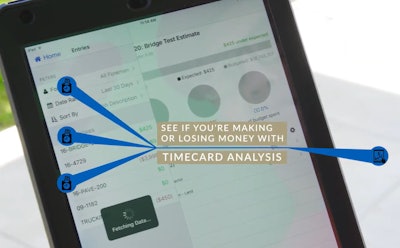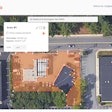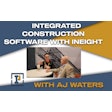
The needs of civil and heavy contractors are unique when it comes to enterprise resource planning (ERP) software. The centricity of equipment, the need to integrate telematics and drone data and the unique business processes typical of earthmoving and civil work are hard to satisfy with the same technology used by building contractors.
What’s remarkable about Sugar Land, Texas-based HCSS is that they started serving this market with software as Heavy Construction System Specialists in 1986. The company name makes clear who the software is for, and this is certainly a pure-play, well-rationalized set of applications for heavy and civil contractors.
HCSS is solidly in the upper end of the middle market, with a few hundred employees. It was acquired in the fourth quarter of 2021 by private equity firm Thoma Bravo, which is heavily invested in software, including another mainstay of heavy civil construction, Command Alkon.
Under Thoma Bravo, Command Alkon substantially re-invented its lead product, launching the Connex platform, which we cover in one of our product snapshot videos. But unlike Command Alkon which had grown by acquisition and really needed a substantial technological reset, HCSS’s broad product portfolio is almost entirely pure play—developed internally and well-rationalized. The lone exception is their HCSS Plans product, which came through a 2017 acquisition of digital planroom vendor BluVue for markup and collaboration on plan drawings.
When IronPros debriefed HCSS in February of 2022, they anticipated Thoma Bravo would infuse capital to build and acquire new products, and to grow internationally. The products can already cover multiple languages, currencies and units of measure. Here at home, the company aims to drive deeper into operations through automated data capture, getting more connected job site data flowing into the product--digitized capture of quality and safety data, specifications from digital RFIs and more.
Start with Construction Estimating
HCSS has some super sexy stuff in its offering, including its drone solution, HCSS Aerial. The solution has seen substantial investment, including a 2021 upgrade that included an integration with HCSS Heavy Job Project Management, along with improvements in calculations and management. But most contractors start at the beginning of the value chain—with HCSS HeavyBid Estimating and Bidding Software.
First off, HeavyBid enables you to pull bid items from department of transportation web sites. You can then match that DOT bid item to historical items you have bid in the past. This is a real time saver. The estimate will build out automatically, in this case generating 85 fully worked up items. You can still analyze and edit these items, making adjustments for conditions unique to the project. You can also fill in missing items by selecting a past estimate, selecting an item on that estimate and then dragging and dropping it to the current estimate.
Construction Operations Software
Once you win the work, HCSS HeavyJob takes over the project lifecycle, tracking cost against projects, digitizing time cards and uniting the field to the front office.
What is impressive about the mobile interface is the design, simplicity and intuitive nature of the interface. Here we see a mobile interface used for timecard analysis, which to me looks almost as intuitive as other solutions for entering time.
Heavyjob makes the important numbers, for instance, very prominent, sticking a variance column all the way to the right. The software also provides insight on how to get the project back on track. And this data is super current because unlike many settings where labor cost is only added to the project financials after payroll is run, this ports n here in real time from the time card and functionality that applies wage rates and business rules accordingly.
There are out of the box tools for common project financial metric like estimate at completion and estimate to completion but then HCSS Intelligence lets you bake your own views if you have something more exotic in mind.
Another significant part of the offering is the Equipment 360 product for fleet management, maintenance and telematics that supports more than 10,000 telematics units operating on heavy equipment.
In all, HCSS offers a broad suite of applications designed for interoperability, but also integrate with multiple products that compete with slices of the offering, including SIS Construct365.We can expect more functionality from HCSS designed to ingest, surface and drive value from data from connected external software and devices. When I debriefed HCSS Vice President of Strategy and Research & Development Tom Webb, he said they are taking seriously the move towards connected construction.
"In North American construction, what we expect is more and more connected job site data coming in," Webb said. "If we were going to tour a typical job site now, we will still see a lot of manual processes. That is quality, safety, digital specifications and other data that come through digital RFIs. There is a great opportunity for all of the products to gain more of a foothold."
Apart from ingesting data from other systems, HCSS places a premium on designing interfaces not just for people, but for people charged with specific roles. This creates extra work for HCSS developers, but results in a more intuitive interface that "gets" the role of each type of user.
HCSS Tech Stack
So what does HCSS have under the hood? HCSS is mostly a Microsoft shop and the software is provisioned on the Microsoft Azure cloud. The company is serious about creating true native apps for mobile devices, using Objective C to write interfaces for iOS devices and in java for Android devices. When you use the software on a laptop over the web, you’re seeing a .NET interface.
Most HCSS applications are delivered on single-tenant server farms—this is not multi-tenant software-as-a-service (SaaS). Now yes, you see a lot of people stressing that multi-tenant SaaS is the way the industry is going—including me. Vendors across the industry and in other industries are de-emphasizing legacy solutions that are single tenant and essentially hosted solutions in the cloud in favor of acquired or newly developed SaaS solutions.
But multitenant is growing mostly because it is more profitable for the vendor. There are important upsides for the customer, but one thing HCSS is showing us here it that there is more than one way to deliver those benefits--like self-service. One question IronPros typically asks software vendors is whether their customers can scale the number of users up and down in the software itself or if that has to be negotiated. This impacts the user experience … it is also a litmus test of whether a product is true multi-tenant SaaS because this type of self service is unheard of in single tenant software environments. However, HCSS is clearly a very advanced single-tenant environment offers this type of self-service capability which is just super cool.
But as the company publishes updates to its software, users are encouraged to test them to make sure they adequately support their workflows, similar to other cloud-based but single tenant systems like Oracle Cloud ERP. So some of the IT admin work associated with single tenant is still here. This suggests to me that the software will be a better fit for heavy and highway contractors in the middle market on up.
HCSS Pricing
Again, one benefit of multi-tenant SaaS is that it can enable a vendor to affordably offer a narrower slice of functionality because they don’t need to spin up an entire environment for that customer. But again, HCSS seems to have some stuff figured out, and offers even its narrower products on a pretty affordable monthly subscription. Sources inside of HCSS told me the team can ramp up an instance of any of these products very quickly, so the barrier to entry for even a small account is relatively low—much, much lower than more horizontal advanced single-tenant cloud ERP products like Oracle Cloud ERP.
But given the expanse of the product offering and its use across multiple departments, many HCSS customers opt for an unlimited user plan license—with a fee based on their company’s revenue. Most products do require a $5,000 startup fee and training and implementation costs.
Right now, new sales are pretty much all by subscription, but some products can still be purchased as a perpetual license for use on premise.
BOTTOM LINE: HCSS is built around a strong culture of caring about customers and end users, with solid first line support, deep online help resources … and this culture is something contractors should look at before they commit to a vendor. They employ about 350 and 200 of those are customer-facing, which again bodes well for HCSS’s ability to grow and serve customers once they sign on.
From a product standpoint, they’re unique. They’ve architected something for communal use without resorting to multitenancy as a way to do that. I just don’t think they have the vocabulary yet to describe what they’re doing and are kind of uncomfortable talking about it. But they seem well ahead from a cloud maturity standpoint of a company like B2W-Bid to Win which has their legacy software parked in a cloud whitelabeled from managed services vendor Loadspring. But they’ll face more and more pressure across their offering, including from multi-tenant players like Tenna, Fleetio, SIS Construct365 and others.
HCSS is doing some super unique stuff in the cloud, but they may be just selling themselves a bit short short. Their approach to single-tenant cloud construction ERP and point solutions like estimating, equipment management, project management may be a strong fit for contractors whether they are leery of multi-tenancy or not.















